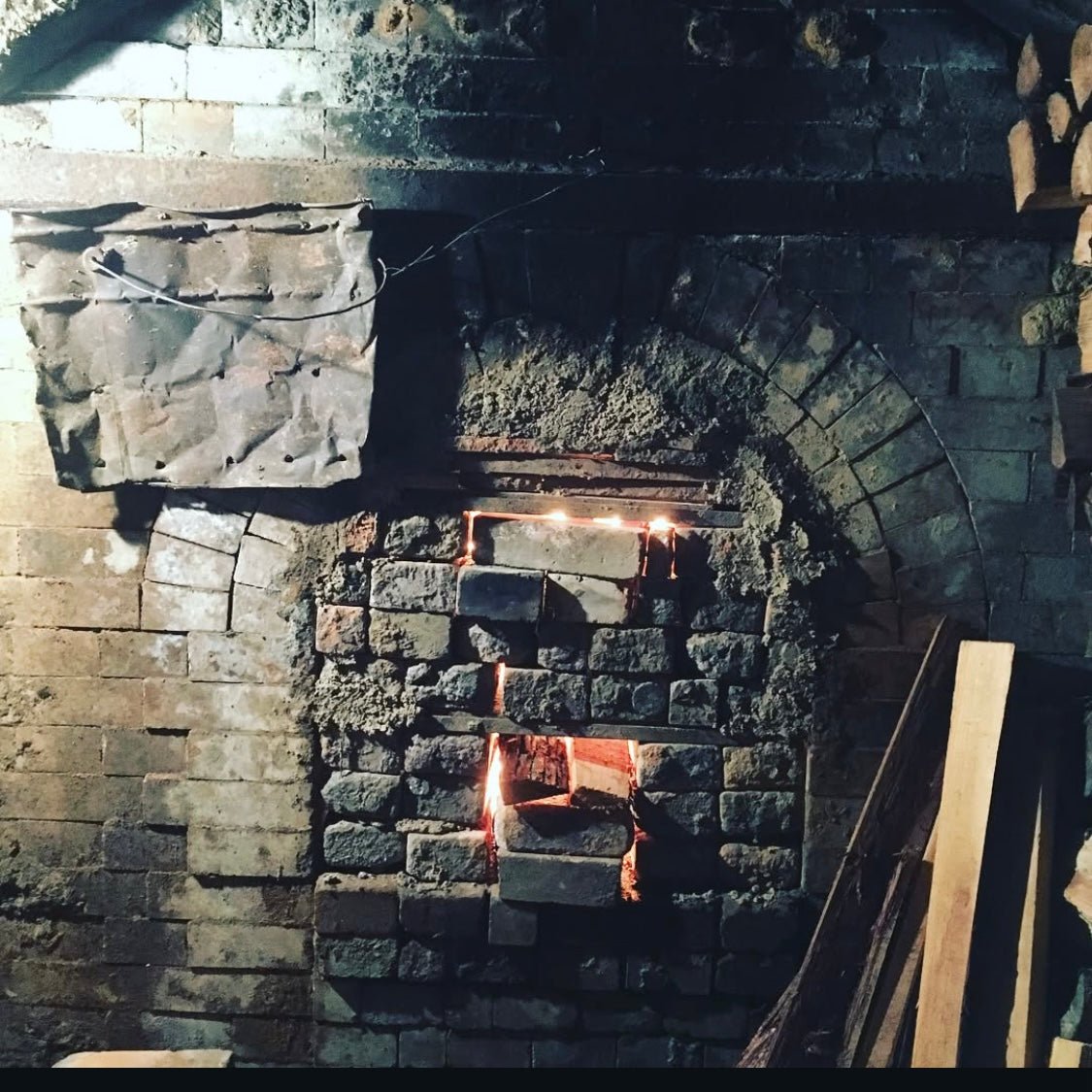Bizen pottery is one of Japan’s most prominent types of unglazed, high-fired pottery, produced in the town of Inbe in Bizen City, Okayama Prefecture, for over 700 years. Known for its earthy texture and durability, it is made by firing clay at high temperatures without glaze. Its origins trace back to the Kamakura period (1185–1333), rooted in Sue ware, which was popular during the Heian period (794–1185).
Mastery of Wood-Fired Kilns and Advanced Techniques
Each artist typically owns their own wood-fired kiln and refines their unique techniques. The clay used in Bizen pottery is highly sensitive to temperature changes, with its color shifting in 10-degree increments starting around 1150°C. This characteristic has significantly contributed to advancements in temperature control and firing techniques. The types of kilns used today are diverse, ranging from small Anagama (single-chamber kilns) and Noborigama (multi-chamber climbing kilns) to massive kilns over 80 meters in size, inspired by the 50-meter kilns developed during the Muromachi period.



Abundant Clay Resources
In Inbe, Bizen City, there are abundant clay resources. It is even possible to purchase unrefined raw clay straight from the ground. This raw clay, essentially a product of natural accumulation, allows for boundless creative potential, enabling artists to produce highly original works. Additionally, Bizen City is a major producer of fire bricks, which are essential for kiln construction.

(Wild clay of Bizen pottery)

Inspiration from History
Artists often draw inspiration from history, including the tea culture of the Momoyama period, the intricate ornaments of the Edo period, and the robust jars of the Muromachi period. Recently, more artists have been reinterpreting Bizen pottery to suit modern dining or artistic contexts. As a result, Bizen pottery is now poised to expand its influence worldwide.
Characteristics of Bizen Pottery
Because Bizen pottery is unglazed, its surface is finely textured. This quality mellows the flavor of beverages like sake, tea, water, and coffee, making it beloved by enthusiasts. Additionally, its resistance to spoilage makes it ideal for flower vases, water basins, and jars. Its ability to maintain moderate humidity also makes it suitable for storing tea leaves, which is why storage jars are so highly valued.
The Present and Future of Bizen Pottery
When I returned to Bizen, I was amazed by the number of international trainees and travelers. A friend of mine used a website offering free lodging in exchange for work and quickly received over 100 requests from travelers. Additionally, Bizen City is home to the Bizen Pottery Art Center, a training facility for learning Bizen pottery, where next term’s trainees will all come from abroad.
It has been five years since I left Bizen pottery, and I have come to realize how blessed the environment here is. The fine clay that can be dug from beneath rice fields, the coarse clay from the mountains, and even porcelain deposits nearby—all these resources make the region incredibly rich. For those interested in wood-fired kilns, the Bizen Pottery Art Center offers both Anagama and Noborigama kilns. Kilns are fired year-round somewhere in Bizen City. Next year, a new art museum will open, further enhancing the area’s cultural appeal.
Previously, Bizen pottery was seen domestically as simple, unglazed ware. Today, however, it encompasses vibrant and sculptural works. The Pottery Art Center offers training programs starting from just one month, so I encourage anyone interested in wood-fired kilns to visit Bizen.
Over its 700-year history, Bizen pottery has continually evolved to meet the needs of its time. Today, artists are dedicated to preserving tradition while exploring new possibilities. Whether their craft has been passed down through ten generations or is a new venture, these creators hone their skills and enjoy long careers. I, too, have worked with Bizen pottery for over 15 years and have learned invaluable lessons that have enriched my life. I believe that my ability to start anew in Canada is thanks to the experiences I gained through Bizen pottery.
Now, after five years in Toronto, I have reconnected with Bizen pottery and am ready to start new collaborative projects. The first initiative stems from a friend of mine, also a potter, who recently acquired a climbing kiln. His wife, Miyuki, expressed her desire to return to pottery, and we agreed to work together to introduce Bizen pottery to Canada. Miyuki began her pottery career in her late twenties, graduating from the Pottery Art Center before apprenticing with a master. However, she stepped away from her craft after marriage and raising child. I felt her exceptional skills and experience should not go to waste. As a first step, I designed pieces for her to create and send to Toronto. Her work features soft, warm forms that pair beautifully with the texture of Bizen pottery. I look forward to sharing the creation process in future updates, so please stay tuned.

(Miyuki's work)
The Contemporary Appeal of Bizen Pottery
Today’s Bizen pottery ranges from avant-garde pieces to traditional works and even creations that celebrate the raw texture of the clay itself. This diversity reflects the talents of many accomplished artists. With the momentum of the current pottery boom, Bizen pottery is poised to shine even brighter. I encourage you to keep an eye on the evolution of Bizen pottery and its many remarkable creators.
Instagram:Bizen Ceramic Center
53-Meter Anagama Kiln Firing on YouTube
Instagram:Mr. Ishida: Creating Pottery Around the World
Instagram:Mr. Mori: Traveling to Art Fairs Around the World
Instagram Mr. Toyofuku: Gaining Worldwide Attention





